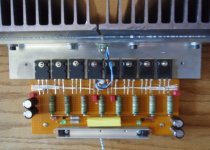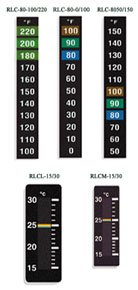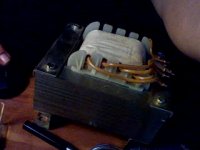Good work thomas!
Mine is the 100W version, ... with colourfull capacitors ... LOL,
it's my main amplifier and i am amazed with it's sound.
Mine is the 100W version, ... with colourfull capacitors ... LOL,
it's my main amplifier and i am amazed with it's sound.
jmmartins said:Good work thomas!
Mine is the 100W version, ... with colourfull capacitors ... LOL,
it's my main amplifier and i am amazed with it's sound.
Thanks jmmartins - I'll look around for some bright color paint and consider adding a bit of color. Does any particular color add to the sound stage - or reduce distortion???

PH104 said:slowly and not so surely .......... the prototype Krill output for my amps. Q7, Q8, Q10, Q11, Q13 and Q15 are mounted on the bottom of the Al angle.
Darn it!! You have brightly colored caps - PLUS LED's!!!

Hey - looks good Phil. BTW you have email about the real mail. 😉
Hey Thomas
A few years ago a hi-fi seller tried to convince me that a pair of white B&W loudspeakers had that sound! … from their colour.
And not a long ago I read about a mechanism to keep the loudspeaker cables hot … and alive?! As I don’t have that mechanism I always awake my cables with some kicking.
Assuming the scientific contribution to mankind knowledge, I decided to investigate the influence of capacitor sleeve colours in reducing TIM, THD and reproduction of coughing in live recorded concerts.
A few years ago a hi-fi seller tried to convince me that a pair of white B&W loudspeakers had that sound! … from their colour.
And not a long ago I read about a mechanism to keep the loudspeaker cables hot … and alive?! As I don’t have that mechanism I always awake my cables with some kicking.
Assuming the scientific contribution to mankind knowledge, I decided to investigate the influence of capacitor sleeve colours in reducing TIM, THD and reproduction of coughing in live recorded concerts.
jmmartins said:Hey Thomas
A few years ago a hi-fi seller tried to convince me that a pair of white B&W loudspeakers had that sound! … from their colour.
And not a long ago I read about a mechanism to keep the loudspeaker cables hot … and alive?! As I don’t have that mechanism I always awake my cables with some kicking.
Assuming the scientific contribution to mankind knowledge, I decided to investigate the influence of capacitor sleeve colours in reducing TIM, THD and reproduction of coughing in live recorded concerts.









I'm experimenting with color-adaptive capacitors which will change color depending on the type of music. I will be selling these under the trade-name "Kameleon Kaps."
PH104 said:I'm experimenting with color-adaptive capacitors which will change color depending on the type of music. I will be selling these under the trade-name "Kameleon Kaps."
Hmmm - maybe we slap on a mood ring crystal and use it to indicate if the amplifier's feelings about the music we are playing. After all - if the amplifier is happy then surely it would reproduce the music with tones that are more cheerful.
Phil - consider applying a coat of thermally sensitive liquid crystal used in temperature strip indicators. They will change color with the temp. Hmmmm - this could work on the xsistors too!!!




:bs:
Attachments
PH104 said:I'm already using mood rings for tube dampers.
What???? Did Ya add tube thingies to your Krill's as well as the LED's??
Plus the mood rings and the "Kameleon Kaps." Man - I'm falling behind the power curve on this!!!

100 W Krill
I see that the 100W version uses a 35--0--35 transformer right?
Any idea how many VA is recommended? (I know more = better).
Also, does the 100W version need any soft start circ, and if so what are people using?
I see that the 100W version uses a 35--0--35 transformer right?
Any idea how many VA is recommended? (I know more = better).
Also, does the 100W version need any soft start circ, and if so what are people using?
Re: 100 W Krill
I bought the ones I'm using for the 50w amps from Steve - they say 160W on the label but I don't see a amp rating.
Steve leaves the choice of soft start - fuses - relays - etc. up to the builder. Lots of ways to go there and much debate regardless of what you do. There is some good info over on the Pass threads tho - and at his web site too. 😉
I'm still in the think'n bout it stage
lgreen said:I see that the 100W version uses a 35--0--35 transformer right?
Any idea how many VA is recommended? (I know more = better).
Also, does the 100W version need any soft start circ, and if so what are people using?
I bought the ones I'm using for the 50w amps from Steve - they say 160W on the label but I don't see a amp rating.
Steve leaves the choice of soft start - fuses - relays - etc. up to the builder. Lots of ways to go there and much debate regardless of what you do. There is some good info over on the Pass threads tho - and at his web site too. 😉
I'm still in the think'n bout it stage

100W requires a 100VA to 200VA transformer.
1.5 to 1.6 times the maximum output power seems to give a good compromise between performance/cost/weight.
160VA is just about an ideal compromise for a 100W monoblock.
1.5 to 1.6 times the maximum output power seems to give a good compromise between performance/cost/weight.
160VA is just about an ideal compromise for a 100W monoblock.
Re: 100 W Krill
When the 100W amp was being manufactured I used a 330VA for each channel. That allowed the amp to produce 200W at 4 ohms and 300 at 2 ohms.
I did not use soft start. I used a 5A normal blow fuse (for 120V) on the AC.
lgreen said:I see that the 100W version uses a 35--0--35 transformer right?
Any idea how many VA is recommended? (I know more = better).
Also, does the 100W version need any soft start circ, and if so what are people using?
When the 100W amp was being manufactured I used a 330VA for each channel. That allowed the amp to produce 200W at 4 ohms and 300 at 2 ohms.
I did not use soft start. I used a 5A normal blow fuse (for 120V) on the AC.
As long as they don't buzz you can use them. After all we are talking about a 5% difference.
Ciao
Andrea
Ciao
Andrea
Thanks, I just got them, very cheap
Yes I will have to power them up, and measure, soon
btw, they are unobtanium now
Handmade by danish transformer specialist, but he has made the pensioner age
Have another pair recently made, and they work perfect, no noise
Anyway, I always lift them up on soft feet, and box ressonance is a no issue
Try to place a stick between your ear and box, and you will know
Even what sounds to be silent appears to be awfully buzzing
Yes I will have to power them up, and measure, soon
btw, they are unobtanium now
Handmade by danish transformer specialist, but he has made the pensioner age
Have another pair recently made, and they work perfect, no noise
Anyway, I always lift them up on soft feet, and box ressonance is a no issue
Try to place a stick between your ear and box, and you will know
Even what sounds to be silent appears to be awfully buzzing
Re: Re: 100 W Krill
I like those numbers. I've got a 600 VA here that should work for 2 channels. I will have to bypass the rectification on each board and do it off-board, but that is easy.
Steve Dunlap said:
When the 100W amp was being manufactured I used a 330VA for each channel. That allowed the amp to produce 200W at 4 ohms and 300 at 2 ohms.
I did not use soft start. I used a 5A normal blow fuse (for 120V) on the AC.
I like those numbers. I've got a 600 VA here that should work for 2 channels. I will have to bypass the rectification on each board and do it off-board, but that is easy.
- Home
- Amplifiers
- Solid State
- Krill construction thread - 100W version


